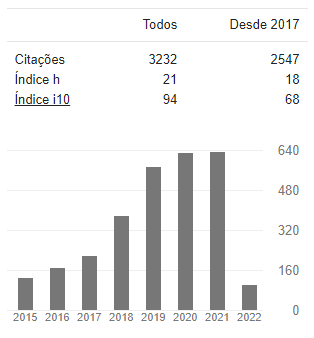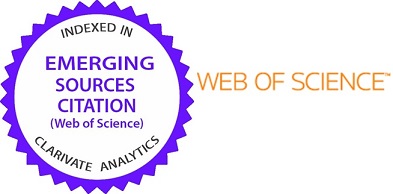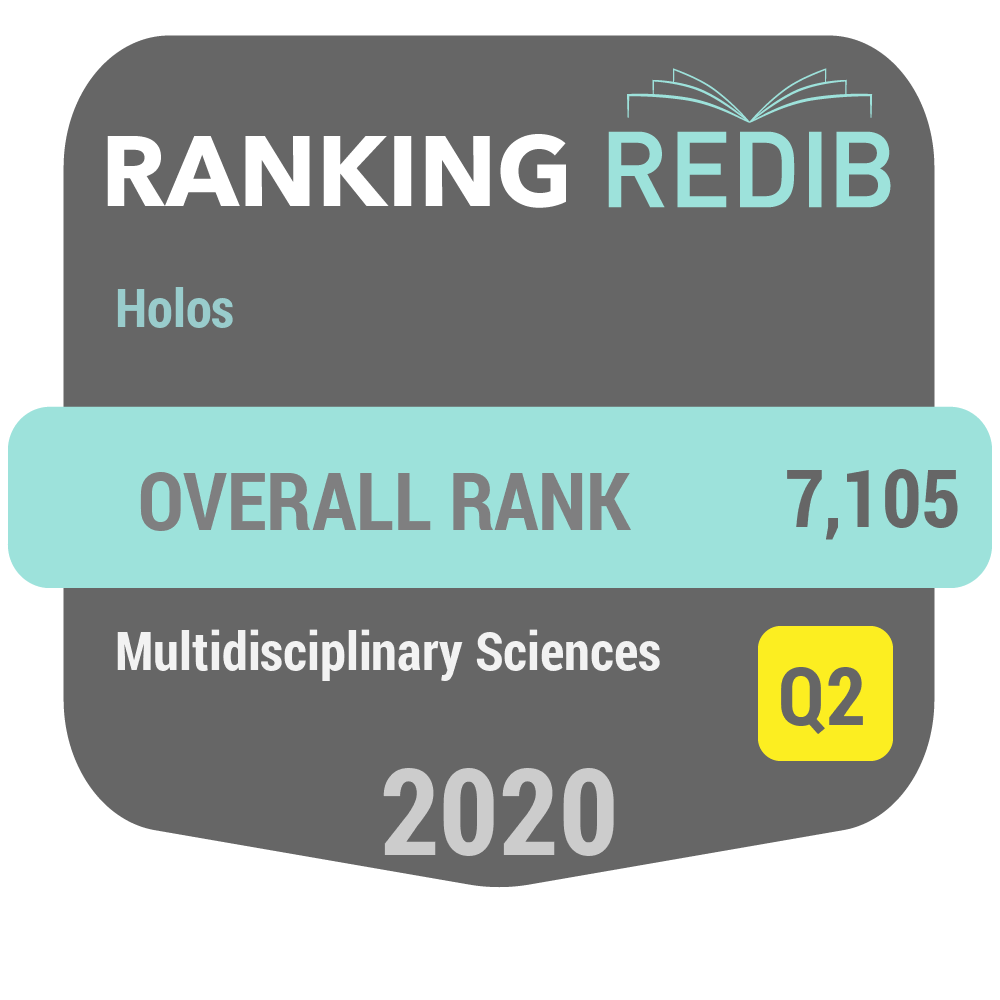Reciclagem de Poliestireno Expandido (EPS) Recycling: Um processo ambientalmente favorável para a recuperação do poliestireno (PS) usando óleo de soja residual
DOI:
https://doi.org/10.15628/holos.2023.16351Palavras-chave:
recycling, Polymer, environmental SciencesResumo
O presente trabalho apresenta um método simples para a reciclagem de resíduos de poliestireno expandido (EPS), utilizando óleo de soja residual (WCSO). O processo de recuperação de poliestireno combina a dissolução de EPS em D-limoneno com sua posterior separação e mistura com WCSO. As propriedades químicas, térmicas e morfológicas do material obtido foram caracterizadas pelas técnicas de Espectroscopia de Infravermelho com Transformada de Fourier (FTIR), Análise Termogravimétrica (TGA), Difração de Raios X (DRX) e Microscopia Eletrônica de Varredura (MEV). As características do poliestireno recuperado apresentaram alta similaridade com o poliestireno padrão (PS), o que sugere baixa contaminação por outros materiais. A grande vantagem deste método de reciclagem é que nos permite obter PS em estado sólido à temperatura ambiente, sem necessidade de aquecimento, ao contrário de outros métodos de reciclagem de EPS relatados. Os resultados são promissores e apontam para um processo viável e simples de reciclagem de EPS, oferecendo diversos benefícios ambientais.
Downloads
Referências
Agoua, E.; Allognon-Houessou, E.; Adjovic E.; Togbedji, B. (2013). Thermal conductivity of composites made of wastes of wood and expanded polystyrene. Constr. Build. Mater, 41, pp.557–562. https://doi.org/10.1016/j.conbuildmat.2012.12.016
Al-Kadhemy, M. F. H.; Rasheed, Z. S.; Sali, S. R. (2016). Fourier transform infrared spectroscopy for irradiation coumarin doped polystyrene polymer films by alpha ray. Journal of Radiation Research and Applied Sciences, 9, pp. 321-331. https://doi.org/10.1016/j.jrras.2016.02.004
Asaad, J.; Tawfik, S. (2011). Polymeric composites based on polystyrene and cement dust wastes. Mater. Des., 32, pp. 5113–5119. https://doi.org/10.1016/j.matdes.2011.06.010
Bellon, D.; Zamudio, W. H.; Tiria, L. C.; Durán, S. M.; Useche, I. E.; and Peña, J. (2019). Effect of expanded polystyrene waste in the creation of waterproofing paint. Journal of Physics: Conference Series, 1386, pp. 012075. https://doi.org/10.1088/1742-6596/1386/1/012075
Brandrup, J. In: Menges G. (1996), editor. Recycling and recovery of plastics. Munich: Hanser.
Campardelli, R.; Oleandroa, E.; Adami, R.; Reverchon, E. (2014). Polymethylmethacrylate (PMMA) sub-microparticles produced by Supercritical Assisted Injection in a Liquid Antisolvent. The Journal of Supercritical Fluids, 92, pp. 93-99. https://doi.org/10.1016/j.supflu.2014.05.012
Choi, N.; Mori, I.; Ohama, Y. (2006). Development of rice husks-plastics composites for building materials. Waste Manag, 26, pp. 189–194. https://doi.org/10.1016/j.wasman.2005.05.008
Espinoza-Merchan M.P., Torres-Parra L.J., Rojas-Arias N., Coha-Vesga P.N. (2020). Recovery and Incorporation of expanded polystyrene Solid Waste in Lightweight Concrete. Ingeniería, 25, pp. 237-249. https://doi.org/10.14483/23448393.15681
Garcia, M. T.; Gema, D.; Ignacio, G.; Antonio, L.; Juan, F. R. (2009). Recycling extruded polystyrene by dissolution with suitable solvents. J Mater. Cycles Waste Manag, 11, pp. 2-5. https://doi.org/10.1007/s10163-008-0210-8
Gil-Jasso, N. D.; Segura-Gonzalez, M. A.; Soriano-Giles, G.; Neri-Hipolito, J.; Lopez, N.; Mas-Hernandez, E.; Barrera-Diaz, C. E.; Varela-Guerrero, V.; Ballesteros-Rivas, M. F. (2019). Dissolution and recovery of waste expanded polystyrene using alternative essential oils. Fuel; 239, pp. 611-616. https://doi.org/10.1016/j.fuel.2018.11.055
Gunstone, F. D. (2002). Vegetable oils in food technology. Composition, properties and uses, 1st edn. CRC Press LLC, Florida.
Gutiérrez, C.; García, M. T.; Gracia, I.; de Lucas, A.; Rodríguez, J. F. (2012). Recycling of extruded polystyrene wastes by dissolution and supercritical CO2 technology. J Mater Cycles Waste Manag, 14, pp. 308–316. https://doi.org/10.1007/s10163-012-0074-9
Gutiérrez, C.; Rodríguez, J.; Gracia, I.; De Lucas, A.; García, M. T. (2014). Preparation and characterization of polystyrene foams from limonene solutions. J Supercrit Fluids, 88, p.92–104. https://doi.org/10.1016/j.supflu.2014.02.002
Gutiérrez, C.; Rodríguez, J.; Gracia, I.; De Lucas, A.; García, M. T. (2016). Optimization of a High Pressure CO2 Antisolvent Process for the Recycling of Polystyrene Wastes. Polymer-Plastic Technology and Engineering, 55, pp. 335-342. https://doi.org/10.1080/03602559.2015.1098676
Jimenez-Francisco, M.; Flores-Johnson, E. A.; Carrillo, J. G. (2020). Effect of Recycled Polystyrene/Limonene Coating on the Mechanical Properties of Kraft Paper: A Comparative Study with Commercial Coatings Journal of Polymers and the Environment, 28, pp. 1724–1736. https://doi-org.ez33.periodicos.capes.gov.br/10.1007/s10924-020-01721-y
JunFei, f.; YiMin, X.; Qiang, L. I. (2010) Preparation of polystyrene spheres in different particle sizes and assembly of the PS colloidal crystals. Sci China Tech Sci, 53, pp. 3088–3093. https://doi.org/ 10.1007/s11431-010-4110-5
Koay, S. C.; Varnesh, S.; Chan, M. Y.; Pang, M. M.; Chantara, T.R.; Tshai, K. Y.; and Cheah, K. H. (2018). Wood plastic composites made from post-used polystyrene foam and agricultural waste. Journal of Thermoplastic Composite Materials, 32, pp. 1-12. https://doi.org/10.1177/0892705718799836
Komoda, M.; Onuki, N.; and Harada, I. (1966). Studies on Cause of Color Reversion of Edible Soybean Oil and its Prevention. Agr. BioI. Chem., 30, pp. 906-912. https://doi.org/10.1080/00021369.1966.10858698
Laskar, I. B.; Rajkumari, K.; Gupta, R.; Chatterjee, S.; Paul, B.; and Rokhum, L. (2018). Waste snail shell derived heterogeneous catalyst for biodiesel production by the transesterification of soybean oil. RSC Adv. 8, pp. 20131. https://doi.org/10.1039/C8RA02397B
Laukautis, A.; Zurauskas, R.; Keriene, J. (2005). The effect of foam polystyrene granules on cement composite properties. Cem. Concr. Composite, 27, pp. 41–47. https://doi.org/10.1016/j.cemconcomp.2003.09.004
Lima, C. E.; Amorim, E. F.; Oliveira, H. da S.; de Moura, L. F. (2021). Dosage of asphalt concrete using civil construction wastes to application in road pavement. Holos, 1, pp. 1-18. https://doi:10.15628/holos.2021.9576
Macedo, M. C.; SOUZA, L.G.M.; GOMES, I. R.B.; MEDEIROS, L.C. (2011). Composite gypsum and Styrofoam for construction of popular houses. Holos, 5, pp. 95-105. https://doi.org/10.15628/holos.2011.658
Makhmud, K.; Alexander, P. S. (2017). Polystyrene concrete as the structural thermal insulating material. International Journal of Advanced and Applied Sciences, 4(1), pp. 40-45. https://doi.org/10.21833/ijaas.2017.010.007
Manrich, S.; Santos, A. (2009). Plastic Recycling. Nova Science Publishers, New York.
Mumbach, G. D.; Bolzan, A.; Machado, R. A. F. (2020). A closed-loop process design for recycling expanded polystyrene waste by dissolution and polymerization. Polymer, 209, pp. 122940. https://doi.org/10.1016/j.polymer.2020.122940
Pol, V. G. (2010). Upcycling: converting waste plastics into paramagnetic, conducting, solid, pure carbon microspheres. Environ. Sci. Technol, 44, pp. 4753–4759. https://doi.org/10.1021/es100243u
Poletto, M.; Dettenborn J.; Zeni M.; Zattera, (2011). A. Characterization of composites based on expanded polystyrene wastes and wood flour. Waste Manag, 31, pp. 779–784. https://doi.org/10.1016/j.wasman.2010.10.027
Rafati, A.; Tahvildari, K.; Nozari, M. (2018). Production of biodiesel by electrolysis method from waste cooking oil using heterogeneous MgO-NaOH nano catalyst. Energy Sources, Part A: Recovery, Utilization, and Environmental Effects, 41, pp. 1-13. https://doi.org/10.1080/15567036.2018.1539139
Sadrmomtazi , A.; Sobhani, B.; Mirgozar, M. A.; Najimia, M. (2012). Properties of multi-strength grade EPS concrete containing silica fume and rice husk ash. Construction and Building Materials, 35, pp. 211-219. https://doi.org/10.1016/j.conbuildmat.2012.02.049
Sarmiento, A. M.; Guzmán, H. L.; Morales, G.; Romero, D. E.; Pataquiva-Mateus, A. Y. (2016). Expanded Polystyrene (EPS) and Waste Cooking Oil (WCO): From Urban Wastes to Potential Material of Construction. Waste Biomass Valor, 7, pp. 1245–1254. https://doi.org/10.1007/s12649-016-9511-7
Singhal, R.; Ishita, I.; Sow, P. K. 2019). Integrated Polymer Dissolution and Solution Blow Spinning Coupled with Solvent Recovery for Expanded Polystyrene Recycling. Journal of Polymers and the Environment, 27, pp. 12(40-1251. https://doi.org/10.1007/s10924-019-01427-w
Vardhan, P. V.; Shukla, L. I. (2018). T-IR investigations on effect of high doses of gamma radiationinduced damage to polystyrene and mechanism of formation of radiolysis products. Radiation and Environmental Biophysics, 57, pp. 301–310 https://doi.org/10.1007/s00411-018-0740-y
Wankasi, D.; and Dikio, E. D. (2014). Comparative Study of Polystyrene and Polymethylmethacrylate Wastes as Adsorbents for Sorption of Pb2+ from Aqueous Solution. Asian J. Chem., 26, pp. 8295-8302. https://doi.org/10.14233/ajchem.2014.16809
Yi-Bo Zhao, Xu-Dong Lv, Hong-Gang N. (2018). Solvent-based separation and recycling of waste plastics: A review. Chemosphere, 209, pp. 707-720. https://doi.org/10.1016/j.chemosphere.2018.06.095
Downloads
Publicado
Como Citar
Edição
Seção
Licença

Este trabalho está licenciado sob uma licença Creative Commons Attribution-NonCommercial-NoDerivatives 4.0 International License.









































